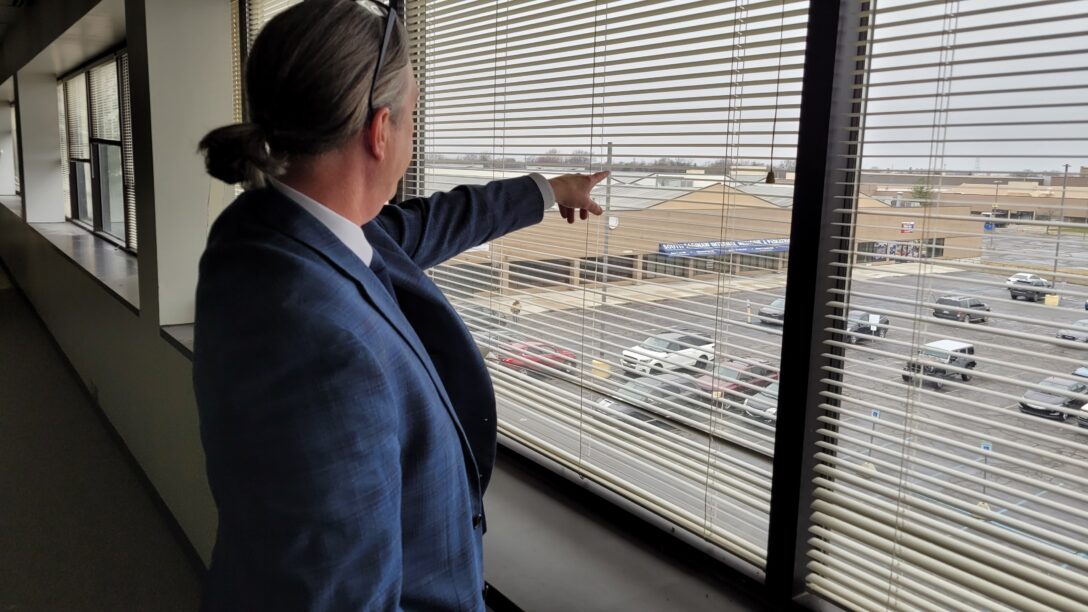Ten years ago, on April 25th, the City of Flint, Michigan, under the thumb of state-appointed emergency operators, switched their municipal water supply from the Detroit Water and Sewerage Department to the Flint River. Governor Rick Snyder’s Republican administration had imposed a brutal austerity paradigm on both Flint and Detroit, where the vast majority of Michigan’s Black population was concentrated. Because the Flint River water was improperly treated, lead from old pipes leached into the municipal water, exposing the city’s residents to elevated levels of lead and other contaminants. Flint Mayor Dayne Walling, who had been in office since 2009, was ousted by voters that November.
Since leaving office, Walling has been completing his PhD in Urban Planning, and continues to serve his home town via government relations for a local healthcare company, Insight.

I met Walling for a conversation in his office, which looks out over the bottom end of South Saginaw Street, on the same campus that once housed the Fisher Auto Plant. One block north, a historic marker sits adjacent to the acreage of buildings that saw the legendary autoworker sit-down strikes of 1936 and 1937. After Insight expanded on the site over a decade ago, they commissioned a large mural on the first floor that places these strikes at the center of the city’s historical timeline.
Walling himself, now 50, is disinclined to spread blame, or to bear grudges. He is still providing testimony in ongoing civil suits, for which Flint residents still have not received remuneration from the $626.5 million fund allocated for their compensation.
“The underlying story in Flint,” Walling told me, “was about the state taking control of the local government… the inadequate treatment and all the catastrophic health and community consequences came from that.”
This interview has been edited for length and clarity.

Tyler Sonnichsen: How has the Flint Water Crisis affected your life?
Dayne Walling: The Flint Water Crisis affected all of us who were here, and in different ways. Up until late September 15, every poll I did showed that I would pretty easily win a third election to the Mayor’s office. So the most immediate effect for me was that in early November 2015, I was no longer in office, so I had to find other outlets for my aspirations for the Flint community.
Beyond that, my family and I found out that part of our home’s own plumbing consisted of lead, which we had to replace. Even though the pipe from the sidewalk to the house was copper, which we could see, the short line from the street to the sidewalk was lead. They were literally going block by block doing those assessments, which required digging down and looking at the pipe, since records unfortunately weren’t accurate across the city.
Is that still going on?
The city has the numbers. I think there are a thousand or so potential lead lines that haven’t been replaced. So it’s largely been completed across the city.
I’ve had to think through and reflect on my shortcomings, in trying to lead through the initial months of the crisis. Why did it take me so long to figure out the way forward? In the years since I’ve been trying to share the lessons I learned with people who are interested, not just in the Flint story, but also in what can be done differently with drinking water across the country—the implications for infrastructure, and for local democracy.
State officials including Rick Snyder issued something of a mea culpa. Do you think they’ve engaged in reflections like yours, and arrived at an awareness of the political realities?
Most of the media accounts now give a good, succinct summary: The disaster was a consequence of Flint switching its water source under the administration of state-appointed managers. But then you need to stop and ask, “What’s a state-appointed manager?” and understand all the complexities around that story. The truth is out there, but not the explanation of it. There’s so much to unpack just in the politics around that phrase. To begin with, the story of Governor Snyder and Republican members of the House and Senate voting in Public Act 4, which strengthened this emergency manager structure, and made an appointed emergency manager responsible not only for financial matters, but for all matters of municipal government. The emergency manager became the mayor and the city council; that’s what the law said. In black and white. In the law.
Voters in Michigan signed petitions and got that law repealed in November 2012. And then the governor and Republican members of the house and senate—because these were entire party-line votes—passed Public Act 436, which looked a lot like Public Act 4, with 432 bills passed in between. Now, the law said, you’ll offer the community a choice between an emergency manager, bankruptcy, or a pre-bankruptcy evaluation process. Flint wasn’t eligible for the latter, because we had already had an emergency declared under Public Act 4.
Why did certain leadership in the state feel that their solution was correct, insisting on shifting the law back, even after voters had rejected it conclusively, in a big November presidential election where everybody and their brother and their sister came out to vote?
And that doesn’t even get into the multiple emergency managers appointed to us. We had four different people in that role; one of them came back after a break, so there were five appointments. One individual was appointed twice.
This law imposed new and different limits on me and the city council. In practice, it removed all of the normal checks and balances between the mayor and council—first of all, because you’re consolidating legislative and executive power in one person—but you’re also consolidating power between local and state government, in one chain of command. In the case of drinking water, that consolidation encouraged a lack of transparency and closed-door decisionmaking in the Michigan Department of Environmental Quality [now EGLE]. Much of how this crisis was precipitated, and how it persisted, had to do with that control of information, the lack of checks and balances, a lack of mandatory open meetings. All the normal things we have to do as government officials, these emergency managers were exempt from.
Was there a moment you remember when it really sank in, how this process was happening?
It happened on multiple occasions, but what was I going to do about it? I still had to do what I could. I was being sidelined in routine meetings—for example, I found out that what the Public Works Director was sharing with me had been filtered by the emergency manager first. I already had no authority over budget, personnel, finance, or legal, an authority critical to managing any organization. On top of that, the normal flow of accurate information from a department head to an elected official had also been sabotaged.
Multiple times, I learned that critical information had been kept from me and city council. And under the law, that was entirely the emergency manager’s prerogative. It was not an accidental outcome, not an unintended consequence; this was a designed feature of the state ticket.
Do people still ask you about the water crisis?
When they find out I served as Mayor of Flint, people absolutely want to know: How’s the water? What really happened?
I’m able to tell them that the water, thankfully, is probably the most tested anywhere in the country right now. It meets the basic standards of the Safe Drinking Water Act, though most of us think those aren’t strong enough, so there’s still work to be done. Moving these final lead pipes, for example, that’s going to be an ongoing issue for us.
When I answer people’s questions, I do go back and talk about the state taking over, because there’s images of me, then as Mayor, flipping the switch. I was there, city council members were there as well. But this isn’t your mayor in a movie who has all this power and can tell everybody what to do. I held the title of Mayor, still had my office, but all the authority was in the office next door with the emergency manager.
And that opens a conversation of the divide we have in this country between Republicans and Democrats, which leads to talking about systemic racism, and how a predominantly African-American community is treated by a State government under Republican control. People are interested in the deeper part of the story—the human tragedy and suffering that we have to acknowledge, and the realization that we don’t want it to happen in other communities, whether with water or any other resources.
Governor Snyder gave his State of the State Address in January 2016, after I had lost reelection, stressing that government failed on all levels, that this had been a government failure. But the governor’s own water commission laid 90% of of the responsibility for the crisis at the door of the State of Michigan. There had been a federal problem with the lack of EPA oversight; with respect to the City of Flint, there were records that were improperly kept, and problems with management and training within the Flint water treatment plant, some things I can acknowledge were subpar.
Personally, I have to see myself in that. Where was my leadership coming up short? Where did I not see a problem and assume enough, because every week mattered, every month mattered.
We got reconnected to Detroit in October 2015, before I left office. What if that could have been September, or August, or July or June? I play that back all the time.
The State of Michigan eventually took responsibility?
To some degree, but much of that owning up came after Governor Gretchen Whitmer was elected in 2018. Because Governor Snyder resisted the civil settlement, resisted some additional aid to Flint. So with that change of administration, there was more focus on the investigation, a willingness to participate, and then the civil settlement, so that people could be, to some degree, compensated for their suffering and their loss. But that took a change in gubernatorial leadership.
Until September of 2015, polling had favored your reelection. Was there a big event that caused the bottom to fall out?
The dynamic changed after Dr. Mona Hanna-Attisha identified that there wasn’t just a risk in our water supply, it was actually causing lead poisoning among our babies. So my next poll, in October, showed a completely changed picture of Flint’s political leadership. Instead of me being 50-55% with a few undecided, it became a third with me, a third with Dr. Karen Weaver, and a third unknown. Because this did happen during my Mayoral term, and people were rightfully angry about that.
When you left office, how did your relationship with Flint change?
Serving as mayor is a very high profile position, and I was in it for almost seven years. It’s a big change, to go from Mayor to not-Mayor. We were at the point where the then-Emergency Manager had left the job in April 2015. We were under the control of a transition board that had to approve every proposal we put forward. Those individuals were gubernatorial appointees. We still had emergency orders in place, forbidding us to change the water source, for example, that weren’t negotiable until the crisis came to a peak. Getting Flint reconnected to Detroit’s water supply in October meant violating those emergency orders, violating the adopted budget, and having to get the governor to agree that this was necessary, this was a crisis, we have to make the change, the state had to come up with money…
So, it’s a very different role when you’re a private citizen.
What should people know about Flint in 2024?
This is a community that is working very hard to go from crisis to recovery and healing. It’s going to be a generational process; the way you get through a process is you take steps, and that is what I see happening in many quarters of the city now. Yes, there are difficult meetings between the mayor and city council, but projects being funded, people seeing that there are opportunities here, that there’s affordable housing. I see us moving slowly from recovery to healing, and that’s going to be the work of this local government for a long time.
In the bigger picture, we’ve made a positive difference with things like the comprehensive Imagine Flint master plan. Our experience shows conclusively that local government is an integral part of this democracy, and we’re going to have to nurture it and invest in it, and when I have the opportunity I tell people, despite everything I’ve been through, I still want good people to step up and run for office.
We’re going to have the first State Park in Genesee County in and around downtown Flint, along the Flint River, on the property that formerly was General Motors, Chevy-in-the-Hole production, a site that was for a long time important to the Anishinabek peoples. No matter how tough things get in Flint, there’s people who do roll up their sleeves, they go to work, they come up with ideas, they debate them with their friends and family and council people.
I put that idea out there of that brownfield becoming a state park in Fall of 2009, and here we are going into Spring of 2024. The state set aside money, with properties being deeded to the State Park system from the city and the county, and I think that’s going to be a really wonderful way to show off what Flint has to offer—one that also honors the industrial heritage, and the heritage of Native American peoples in and around this area by making this green space very accessible. There are some built features, but it is mostly a natural and native landscape to this part of Michigan.
I think there are times when we can hang on too much to what I’ll call the near-past, and not thinking deeply or clearly of the centuries of history that this place has. There’s still a lot of the attachment to the heyday of General Motors growing and expanding. When we go in and look real closely at that, we see that a lot of people were excluded from that affluence; this is going back to the redlining and racial residential segregation.
We just have to run faster towards the future and do more, more quickly to improve our neighborhoods, make access to education and jobs more available to more people.






